Panel Beating - 3rd August 2006

Well, I bet you thought you'd seen the last of Panel Beating, didn't you? No such luck, I'm afraid. I've been unutterably lame lately (cue cries of "So what's new?" from the wags at the back), being unable to find the time or indeed the brain power to actually get my head in gear and write about the comics I've been picking up over the past few weeks. Each week, I've duly created the entry for a new column (as an actress said to a bishop) on the NTS system, and then ended up changing the date as deadline after deadline has whooshed past making that noise of which Douglas Adams was so fond. Anyway, we're finally back, with a set of reviews of books that have come out in the past fortnight. I really am going to try and get back on to some kind of schedule as soon as I can - although whether that becomes a weekly schedule or a fortnightly one will, unfortunately, depend on a number of factors. So, if you can actually stomach continuing reading, then please come this way for - at last - some fresh reviews...
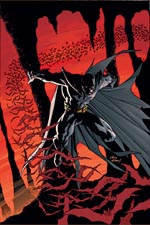 |
BATMAN #655
Publisher DC • Writer Grant Morrison • Artist Andy Kubert
Well, it's hard not to get excited, really, isn't it? I've gone on about how great I think Grant Morrison is so often in this column's short life that it's not even funny. Here is a man who not only has a deep and inherent understanding of how to write great comics, but of the superhero genre in general to boot, taking over one of the industry's most popular characters of all time. Now, to be honest, as slightly less of a Batman fan than I am a Superman fan, this does excite me a bit less than the idea of All-Star Superman - but even so, it's Grant Morrison. Writing Batman. It's about as no-brainer as it comes, really.
Still, though, the thing about Grant is that, generally, you can separate his work into three piles. There's the genuinely stunning, groundbreaking work that simply demands attention, that appeals to readers across a broad spectrum, and just cannot be ignored by anyone with even the most passing interest in comics - All-Star Superman, Animal Man, Zenith, We3 and parts of New X-Men. Then there's the quirkier, idiosyncratic stuff, the material that's obviously been lifted directly from his unfathomable, drug-addled brain; obviously genius craft at work, and probably closest to his heart, but often incomprehensible if you're on nowhere near the same wavelength as him - The Invisibles, Seaguy, Doom Patrol, The Filth. And then there's the bread-and-butter stuff. Great, solid, superhero books, a thoroughly entertaining read but nothing that's ever going to change the world - JLA, Aztek, the rest of New X-Men, and so on. You'd hope that his Batman run might fall into the first category. Sadly, on the evidence so far, it only makes it into the third - still great fun, quality superhero stuff, but it's no All-Star Superman.
It certainly gets off to a flying start, though, with a terrifically entertaining opening scene featuring the Joker. Not only does he deliver a laugh-out loud funny line on the third page, but Morrison immediately hooks the reader by throwing them into a shocking scene in which all is not as it seems. Incidentally, I've read confusion from various reviewers about what's actually happening in this scene - I'm not quite sure why, as it's all quite clearly explained immediately afterwards, and I don't think the storytelling's so unclear that you can't see for yourself what's going on. But hey, that's just some people, I suppose. Anyway, the momentum is carried on through a great Batcave scene in which both Alfred and Tim get a chance to shine as the dialogue zings back and forth (Alfred, indeed, getting just about all the issue's best lines save for that early Joker one).
The second half of the issue sees Morrison begin his exploration of what he's going to do with the character, and it's an interesting one. In marked contrast to James Robinson's run, which established the return of Bruce as Batman, Morrison here has him recognise that he needs to spend just as much time re-cultivating his "wealthy playboy" persona, and so we see him attempting to integrate himself back into socialite life in a scene that seems to take a number of cues from Christian Bale's portrayal in Batman Begins.
All of this then leads up to a final-page twist that, sadly, is already predictable - if not downright given away - by the story's title, "Batman & Son". It's certainly a curious one. If he is indeed bringing Batman and Talia Al Ghul's out-of-continuity son into the fold post-Crisis, then it will be a contentious move. But, of course, this is Morrison we're talking about - "all is not as it seems" could be a mantra for his storytelling, and you almost wonder if the amount of misdirection in the early pages of this issue is a deliberate flag-up for what's to come during the rest of the arc. Either way, a good analysis of Batman and the various surrogate "son" figures he's had in his time is surely to follow, and that's a welcome thing.
I'm not so big a fan of Andy Kubert as some, nor can I ever really tell him apart from his brother, but his work here is pretty solid. There's an interesting Jim-Lee-esque tone to the opening pages, particularly in the portrayal of the Joker, and part of me can't help but wonder how deliberate that is. Interestingly, though, he settles down better when drawing Bruce out of costume - it's something that many artists struggle with, making him look too generic, but Kubert comes up with a strong-jawed, forceful Wayne, and affects the transition to grinning, soft-headed playboy well, too. All in all, it's a very good start, the sort of thing that would easily attract an A+ had it come along in the midst of any normal run on the book. But this isn't any normal run, it's Grant Morrison - and by his own high standards, it's "great" rather than "stunning". He's not reinventing the wheel with this - but then, maybe that's not the intention. A
 |
NEW AVENGERS #22 (PICK OF THE FORTNIGHT!)
Publisher Marvel • Writer Brian Michael Bendis • Art Leinil Francis Yu
There have been times when I've regretted adding New Avengers to my pull list. I missed all the fuss of the first ten to fifteen issues, steering clear - despite being something of a Bendis fan - after the debacle that was Disassembled. My loss, apparently, as all that certain Marvel Zombies (such as Mr Hunt) could tell me was that it was a terrific read. Unfortunately, I started to pick it up in the midst of the post-House of M fallout, and that led directly into Civil War - in which the team has, for obvious reasons, begun to fall apart - so it seemed like I'd completely missed out on the exciting and fresh storytelling and setup that the book had earlier offered.
Well, that's as may be, but at least I've been able to catch on to the one final hurrah that Bendis has given the book before CW finishes off this lineup for good. Heck, I almost didn't pick up this issue after the disappointment of the last few - but the guy in my LCS persuaded me to, and I'm glad I did. This was fantastic.
Powers notwithstanding, in recent years Bendis has been by far at his best when he's been able to explore his "pet" characters, Jessica Jones and Luke Cage. One a new character created by Bendis for his marvellous Alias series (and criticised, unjustly, by many for the way she's been retrospectively dropped into Marvel continuity), the other a formerly laughable superhero from the 1970s known mostly for his silly yellow costume and unrealistic "jive" talking. In Bendis' hands, however, they've both become deeply human characters, each with their own flaws, but with a strong and obvious loving relationship that has grown organically over the last few years. Simply put, whenever they show up on the page together, it's always an absolute joy - but with Jessica no longer the focus of her own series, such opportunities have been restricted to squeezing them into the pages of New Avengers wherever possible.
Here, though, with the Civil War tie-in storyline apparently devoting an issue to each member of the Avengers and their reaction to the Registration Act, we get an entire issue focusing on the pair (and Cage in particular). And, as you'd expect, it's an absolute joy. Once again, it's hard not to feel uneasy about the fact that both sides of the argument really aren't being represented by any of the series - because once again, here in a debate with Iron Man and Ms Marvel, Luke and Jessica are given the opportunity to be the completely sympathetic party, with their reasoning standing as much more solid. Luke's comparison with the South in the 1950s may strike some as a little tasteless, but it's surprisingly well justified within the text - and it's something that Stark really doesn't have an answer for. Jessica, meanwhile, raises the interesting question of what the powered characters who have no intention of ever using their powers again, and who don't want to be beholden to the government, are supposed to do.
Strongest throughout the issue, however, is the deep bond between Luke and Jessica, and moreover their burning desire to do what is right (and Bendis leaves us in no doubt as to what he feels the "right" course of action is), both for themselves and for their young child. It's hard not to cheer Luke on, particularly in the climactic battle scene - and the hilarious tank-stealing scene that immediately follows. Just as in the New Avengers annual, and just as in the last issue of The Pulse, it's hard not to warm to these two characters who, despite their flaws, are possibly the most real characters the MU has to offer. We care about their fate, we care about how the Registration Act will affect them - although using them in this way does perhaps present problems for the longtime Marvel reader, as this only serves to make Stark et al the "Bad Guys" even more than they have been before.
Leinil Francis Yu is an interesting choice for this one, especially in the light of the announcement that he'll be taking over the book full-time when Civil War is done. He's the sort of artist that grows on you - I recall starting Superman : Birthright, and thinking him totally wrong for the character and story, but loving his approach by the end (elements of which are still seen in the interpretations of people like Pete Woods and Renato Guedes). He's definitely better at action than talky stuff, meaning that this issue isn't the best showcase for his talents, but his characters are almost all spot on - most notably his Cage - with the exception of Jessica, who doesn't quite look right (but then, she never does if it's not Mike Gaydos drawing).
But this one's not really about the art. It's about Bendis, the characters he loves, and the characters he writes the best. It's probably the best of any Civil War-related issue - main series or tie-in - so far, and at a time when people are beginning to question the quality of both the concept and execution, he shows exactly how to do this sort of thing - casting characters in a new light, and giving you the chance to really think about them. More like this, please. A+
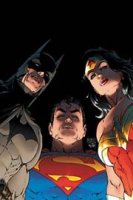 |
JUSTICE LEAGUE OF AMERICA #0
Publisher DC • Writer Brad Meltzer • Art "An All-Star Cast of Artists"
I was quite pessimistic about the idea of Brad Meltzer on JLA, but looking back - with the hindsight of having read this issue - I'm not really sure why. I mean, sure, Identity Crisis degenerated into a bit of a disappointment towards the end, with a completely rubbish reveal; but there was also some strong storytelling and - crucially - good character understanding in those early issues. Those who point to Meltzer as being the man who kickstarted all the unnecessary darkness and unwanted nastiness that characterised the DCU in the years leading up to Infinite Crisis are, I think, barking up the wrong tree somewhat. And then there's his Green Arrow work - where with the tough job of following Kevin Smith, he turned in some decent work that again showed a good understanding of various characters and their voices.
Even so, though, I wasn't massively optimistic about this issue in particular - one of those dreaded "#0s", designed as a chance to set up the new series and rake in a few extra quid, while not actually being an essential story that you need to read in order to understand #1. Such things - even when drawn by "An All-Star Cast of Artists" - never tend to be much more than mildly entertaining filler.
This, though, was great. Less about the Justice League itself - though it does represent a pleasing nostalgia trip through the various generations, with nobody's favourite version missed out - and more about the relationship between Bruce, Clark and Diana, it marks an important moment in the "New DCU" as we're given a firm assertion of where their relationships stand right now. After years of misunderstandings, confusion and fluctuating takes borne out of inconsistencies in writers, we now have firmer ground on which to stand - and Meltzer provides justification for the current status by re-establishing Batman and Superman as once having been good friends, before charting the ups and downs of their relationship and drawing a natural conclusion.
The nature of the issue - each page jumping between chronological scenes from the JLA's past and random scenes from possible (or probable?) futures - means that it's actually well-suited to having such a wide team of artists. While it might not be quite such a superstar roster as was gathered together for Superman/Batman a short while back, there are some names that it's great to see pop up - the respect shown to the Giffen/deMatteis JLI by having Kevin Maguire draw a discussion about the infamous Guy Gardner "One Punch!" incident, for example, is particularly pleasing in light of recent events which have made it seem like those characters are completely unwanted and unloved by the current editorial staff. Meanwhile, it's great to see Tony Harris on a mainstream DCU book again - not that I hold out hope that his schedule might allow for it to become a regular thing, but his art's so great that it's just nice to see crop up.
As a dissection of the relationships between the three most important characters in the DCU, this is great stuff for the long-term fan. The era-hopping is pleasing to anyone who's followed some or all of these generations, while the glimpses into the future are intriguing in the hints they drop and the questions they leave unanswered. It's not an essential story, by any means - and it is cleverly pitched so that any reader would be able to pick up JLA #1 in a couple of months and be blissfully unaware of its existence - but it works both as a teaser for the future and a pleasant and respectful homage to what's gone before. A
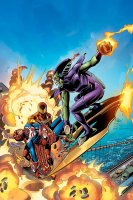 |
FRIENDLY NEIGHBORHOOD SPIDER-MAN #10
Publisher Marvel • Writer Peter David • Pencils Mike Weiringo • Inks Karl Kesel
Eep. What an incomprehensible mess.
Let's stop and consider this. This is Peter David. And Mike Weiringo. On Spider-Man. It's been running for ten issues, now. It should have been great. Why, then, is it so bloody awful? I mean, I know to begin with it was mired in the awfulness of the Other crossover, but that's long gone now - this comic's had ample opportunity to establish itself as a great Spidey title. But we've had two or three false starts, now - a couple of occasions where a story has threatened to be quite good, and degenerated into mess - and this is the worst of the bunch.
I simply do not understand what's supposed to be happening with this story. Oh, I understand the core tenet - the daughter of a future descendent of Spider-Man, conveniently named "Hobby" (a contraction of "Robin" that I have never come across before - seems like a case of PAD making a nickname out of "Hobgoblin" and working backwards), is calling herself the Hobgoblin and attempting to eliminate various Spider-Men from their timelines, while an alternate version of Uncle Ben from another timeline is somehow trapped in our universe. What I don't understand is what the point is. I don't understand the motivation behind Hobby's actions, but more importantly, I don't understand what David is trying to do with the story - what point it serves. Is it supposed to show Peter the possible lives that he could have had? If so, then why is so much focus given to this annoying girl in her hideous costume, and her bland and rubbish father in his even more hideous costume, while Peter himself gets to be little more than a confused bystander?
And what is going on with all the Uncle Ben stuff? When this arc began, I thought the idea of an alternate-universe Ben getting the chance to see what life would have been like without him - and vice versa - was a quite neat one. Unfortunately, the story isn't like that at all, with Ben just hovering around as a background character - with nowhere near enough page space devoted to his story - until an absolutely gobsmackingly awful twist at the end that leaves the entire story unresolved, with an unwanted element still floating around the Marvel Universe and a distressing amount of ambiguity (Who is the second Ben? Where did he come from? What are his motivations? And which one of them is that in the alley at the end?).
The completely underwhelming nature of Weiringo's usually-kinetic art is surely testament to the stupefying torpor of the story - but while he may be able to blame bad plotting on his inability to create any excitement, I don't know who he'd care to blame for the utterly awful "Spider-Man 2211" costume design. Looking like a really bad 1990s action figure, every time the character shows up he destroys the credibility of the story yet further. There are moments in this story - a quite decent scene with May, Alt-Ben and Jarvis, and a few smirksome lines from "Hobby" (as you'd expect from PAD) - but that's all they are. Moments. In an otherwise deeply unsatisfying - and downright infuriating - whole. This book's been on borrowed time for practically its entire existence - and I think, at least as far as my patience is concerned, that time has just run out. C-
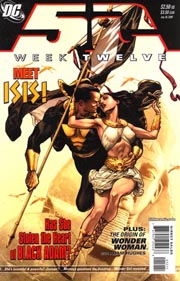 |
52 WEEK TWELVE
Publisher DC • Writers Mark Waid, Grant Morrison, Greg Rucka, Geoff Johns • Breakdowns Keith Giffen • Art I dunno, some guys.
Well, it's definitely getting there. The last two issues of 52 have shown a marked improvement on the few that preceded them, returning to the sort of promising form the book demonstrated in the first couple of issues. Key, I think, has been choosing the right characters to focus on - keeping Montoya/Question as a running thread (even in this issue, where the focus is off them, they're given a few pages in order to connect to last week), giving a lot more page time to Black Adam (the undoubted star of the book so far), and giving us a couple of weeks off from the irritating Booster Gold and Steel stories.
Finally getting round to introducing a couple of significant new characters has helped, too. Week Ten gave us Supernova, but before we could wonder about the nature of his identity, Week Eleven gave us the much-hyped Batwoman. Both were exciting introductions, but they've both been trumped this week by a character we didn't even know was coming - the latest member of the Marvel family, Isis. The relationship between Adam and Adriana has been one of the most interesting elements of 52 so far, but I certainly didn't see this one coming - all of a sudden there's a new girl on the block, and someone who looks like she can out-Wonder Woman Wonder Woman, to boot.
Meanwhile, Ralph Dibny's story continues, and while I'd still place it as one of the "middling" of the concurrent storylines, the intrigue is at least advanced further here. It's a shame that the other main character in this story is Wonder Girl, though, since I've always found her to be pretty annoying. Still, the twist in Ralph's motivation is a surprise one, and it'll be interesting to see where things go from here. As an aside, though, here's an interesting point I spotted - a character called "Devem" is mentioned as being the leader of the Cult of Superboy. Now, in pre-Infinite Crisis continuity, there have been various characters called Dev-Em - but they've all shared one thing in common, namely they've been insane 30th Century-based Kryptonians or Daxamites. Given that Keith Giffen (former Legion of Super-Heroes writer/artist) and Mark Waid (current Legion writer) are both currently working on this title... could there be a connection?
I've no idea who the current artists on the book actually are, since they're only listed by surname, I've never heard of them, and the DC website doesn't give their names either. Certainly, though, the art over the last couple of issues has also shown improvement - although I'd still like to see some big hitters cropping up should they find the time, as at the moment it all just feels rather generic. Still, though, the introductory splashes of both Batwoman last week and Isis this time out were well handled. Meanwhile, Adam Hughes turns in the first "Origin Of..." two-page backup, and while the story of Wonder Woman offers potential confusion (simply because the main WW book doesn't actually have Diana as WW... yet), it's Adam Hughes being all Adam Hughesey, so you know it's nice to look at.
It's a crucial time for 52, as the switch in its ordering status (don't make me pretend to understand it) means that it will now be more reliant on people sticking with it week upon week. Thankfully, though, for the past couple of weeks there have been real signs that the series is going to start doing significant things to the DCU, and cast some fresh light on all the One Year Later stories, to boot. As such, it remains a worthwhile venture - and for the moment at least, a good read. A-
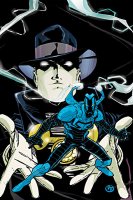 |
BLUE BEETLE #5
Publisher DC • Writers Keith Giffen & John Rogers • Artist Duncan Rouleau
Against all expectations, Blue Beetle continues to be one of the most entertaining pure superhero books that DC have put out in a long time. I've said it before, and it bears repeating, that this really is textbook stuff - but the textbook is Marvel's, as Jaime's early days as a teenaged, misunderstood hero bear more than a token resemblence to those of a certain webhead. Thankfully, it comes off as fresh and interesting rather than uninspired - and with both this and the All New Atom, DC really are doing quite well out of these new-characters-under-old-names (Flash doesn't count, 'cos Bart Allen's not a new character).
The quality of the writing team undoubtedly helps. Keith Giffen's work is almost always dependent on whom he collaborates with - because he really isn't a dialogue guy, never has been. He needs someone like J.M. deMatteis alongside him, someone who can come up with laugh-out-loud dialogue at the drop of a hat - and more importantly, whose sense of humour ties in symbiotically with his own. And it seems that in Canadian John Rogers, he's found another perfect match.
It's not like Blue Beetle is out and out comedy, of course - although it generally turns up the odd laugh-inducing line (nothing yet to match "Because the Swedes are filthy spawn campers!" from issue one, though, but the Life on Mars reference last month came close) - but simply that, like all of Giffen's best work, it's based around a quirky group of organic characters. The central trio of Jaime, Brenda and Paco already have some great interplay, and Giffen and Rogers are quickly establishing a wider supporting cast by bringing the "Posse" into the fold. The idea of a street gang formed by youngsters with super powers is hardly the most original, but it fits in well with the tone of the book.
There's a slight disappointment this time out in terms of art, though, as Duncan Rouleau stands in for Cully Hamner. Not that his work is terrible, and it at least maintains a consistent tone with previous issues despite being somewhat looser and scratchier - but Hamner's art in the early issues has been so excellent that it's really just a shame when he's not around.
The hints that continue to be dropped about the dubious nature of the Scarab's motives look like building to a payoff next month, and it's been an intriguing way of leading in to a new character by immediately having almost every other hero he encounters be suspicious of him, simply through a "feeling" that the Scarab has given them. Certainly, Jaime is continually having to wonder whether it's a curse or a blessing - and while that may be par for the course over at the House of Ideas, it's nice to see such a thing explored in a DC book. His innate desire to do right - not because he feels he should, but because he can - is marking him out as a strong character already, and against everything that we might have expected, he may yet become a worthy inheritor of Ted Kord's mantle. A
NEXT TIME...
Next week's a bit of a quiet one, so don't be surprised if it's another fortnight before the next column. Next week sees the second issue of The All-New Atom (I didn't get a chance to cover issue #1, but it was surprisingly good), Paul Dini and JH Williams continuing their so-far excellent team-up on Detective Comics, and the continuation of "Smoke Smoke", a story described as one of Ex Machina's most controversial yet. Over at Marvel, meanwhile, Ultimate Spider-Man continues the Clone Saga we thought we'd never see. In two weeks' time, it's even quieter - with 52 the only obvious draw from DC, and the second Ultimate Spidey Annual. Oh, and there should have been a Powers this week, but it didn't show, so hopefully that'll pop up at some point as well.
About this entry
- By Seb Patrick
- Posted on Thursday, August 03 2006 @ 11:57 pm
- Categorised in Comics
- 2 comments

I always enjoy your and James' columns, Seb, despite knowing jack shit about comics. By the way, what did you think of The Incredibles? Me and John watched it last night, and still thought it was amazing. I particularly enjoyed the '60s styling throughout, which complimented the James Bond-type lair of Syndrome.
By Tanya Jones
August 04, 2006 @ 1:32 pm
reply / #
I think it's up there among the very best superhero movies ever made. I think it could show a lot of the people who are making movies that are actually based on comics a thing or two about how to go about it. I think it's a better Fantastic Four movie than the actual Fantastic Four movie. I absolutely love it.
By Seb
August 04, 2006 @ 1:51 pm
reply / #